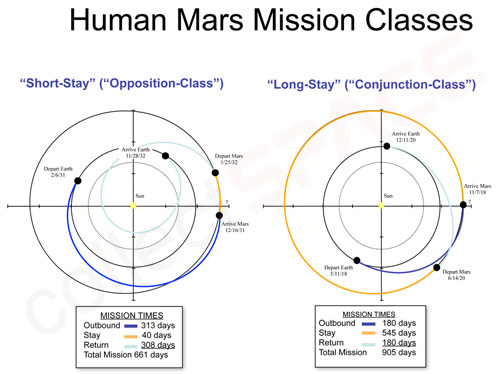|
Author
|
Topic: Mars: the long haul or the short stay?
|
Robert Pearlman
Editor Posts: 50516
From: Houston, TX
Registered: Nov 1999
|
 posted 05-16-2007 06:44 PM
posted 05-16-2007 06:44 PM
   
This slide, shared by someone@nasa.gov, shows two preliminary scenarios for how to send humans to Mars: 
Click above to enlarge.(The dates only represent an opposition/conjunction cycle and aren't meant as targets for a first mission.) A layman's debate: Which approach makes more sense to you? The shorter stay requires a longer voyage while the longer expedition reduces the journey in both directions. There are risks and advantages associated with both.
Edited by Robert Pearlman |
KSCartist
Member Posts: 3047
From: Titusville, FL
Registered: Feb 2005
|
 posted 05-17-2007 07:04 AM
posted 05-17-2007 07:04 AM
   
I think the first "manned" mission will opt for the shorter stay - and shorter mission timeline. Eventually a shorter trip and longer stay will become the norm. Either way I don't think you'll see astronauts going to Mars more than one time as their "lifetime radiation exposure" will not allow that. Tim |
mjanovec
Member Posts: 3811
From: Midwest, USA
Registered: Jul 2005
|
 posted 05-17-2007 10:39 AM
posted 05-17-2007 10:39 AM
   
I also think the shorter stay makes the most sense for the first trip. Even though the trip itself is much longer both ways, the overall mission is quite a bit shorter. If radiation exposure is at all a concern, it would make sense to do the 661 day mission first to see if the measures taken would hold up for 905 days as well.Plus, they will be launching off of Mars at Day 352, not Day 725. That's a lot less time for equipment to break down or malfunction. While every effort should be made to ensure the equipement is robust and has built in redundancy, it makes sense to be conservative on a first flight. For an initial exploration, 40 days is a good amount of time. When Mars is ready for a "J Mission," the 545 day stay can be attempted. On a personal note, if *I* were an astronaut going to Mars, I'd opt for the shorter stay too. I simply don't know if I'd want to spend 545 days on Mars. 
Edited by mjanovec |
tegwilym
Member Posts: 2339
From: Sturgeon Bay, WI
Registered: Jan 2000
|
 posted 05-17-2007 11:15 AM
posted 05-17-2007 11:15 AM
   
I vote for the short stay - at least for the first mission. Then if it's worth going back for longer....
|
Lunar rock nut
Member Posts: 916
From: Oklahoma city, Oklahoma U.S.A.
Registered: Feb 2007
|
 posted 05-17-2007 12:07 PM
posted 05-17-2007 12:07 PM
   
I will agree with the short term stay. I would believe that more technology could carried and deployed for long term science rather than provisions needed to sustain astronauts for the extended stay on the first trip. Forty days should be plenty of time to survey and collect samples etc. I would also think this option would be better for rotating personel if a base is eventually established. Terry
Edited by Lunar rock nut |
E2M Lem Man
Member Posts: 846
From: Los Angeles CA. USA
Registered: Jan 2005
|
 posted 05-17-2007 04:19 PM
posted 05-17-2007 04:19 PM
   
When most of us were kids we were told we could only go to Mars for the longer stay.It is refreshing to see this new profile. Eventually longer will be normal. But shorter at over 500 days, is so much safer. Logically we will have to rehearse the mission profile in 'near' Earth space to make sure all systems will hold up for the long haul (reference: Apollo 7 thru 10) before we send in the first landings. The longest Apollo missions were still only three days on the surface. 40 days is a long time to start! Now lets start building these. Jim Busby
Edited by E2M Lem Man |
Robert Pearlman
Editor Posts: 50516
From: Houston, TX
Registered: Nov 1999
|
 posted 05-17-2007 04:57 PM
posted 05-17-2007 04:57 PM
   
I'm surprised not to see more people here advocating for the longer stay and shorter trip. It would seem to me that the greater risk to the crew would be during the trip to and from Mars. Other than the threat from radiation, I would think that the risks from impacts, system failures and the physiological degradation caused by long duration exposure to microgravity (to say nothing of the psychological challenges) would be the priority to mitigate. Beyond that though, if I were a member of the crew and had the choice, I think I would rather spend a year traveling for a year and a half on the surface rather than spend nearly two years traveling for just a month and change to explore. Forty days is not enough time to scratch the surface (literally and figuratively). I'd want the opportunity to traipse about the planet without feeling like I was on a tight deadline to get back. I would really hate it if I made such a long journey only to find out on my return that I had stood at the edge of Cone crater and didn't have the time to realize it, look in and rappel down its side...
Edited by Robert Pearlman |
Danno
Member Posts: 572
From: Ridgecrest, CA - USA
Registered: Jun 2000
|
 posted 05-18-2007 10:03 AM
posted 05-18-2007 10:03 AM
  
Unfortunately, there are other options that are not being looked into. These people are only looking into minimum energy trajectories as that is what classic orbital mechanics teaches. There are other high energy options that allow a crew to get to Mars in about a month, stay there for a little over a week, and then make the trip back in about a month. This is all done when Mars is making a close pass to Earth and is not a difficult thing to do. |
mjanovec
Member Posts: 3811
From: Midwest, USA
Registered: Jul 2005
|
 posted 05-18-2007 10:21 AM
posted 05-18-2007 10:21 AM
   
I had read that Von Braun had a pretty detailed writeup on how to get to Mars. I wonder if such writeup outlined the length of the trip and the length of the surface stay. I would be curious to compare what he proposed vs. the two options shown here. |
davidcwagner
Member Posts: 991
From: Albuquerque, New Mexico
Registered: Jan 2003
|
 posted 05-18-2007 06:50 PM
posted 05-18-2007 06:50 PM
   
I think the first Mars mission or two will be orbital only. No manned landing. This mission profile would be cheaper, lighter and sooner than a manned landing.While in orbit the crew would drop a series of rovers, fliers, drillers, and sample return probes directed to pre-selected sites and even some "target of opportunity" sites selected by the crew. The sample return probes would boost to the mother craft and allow sample collection from a number of sites. The manned craft would "land" on Deimos and Phobos. I believe that Deimos and Phobos are as interesting as Mars. Phobos is in a "Death Spiral" orbit destined to collide with Mars in an eye blink of geologic time. There is some natural, little understood, process that puts asteroids in Death Spiral orbits around planets. Moving Phobos into a stable orbit would be good practice for a possible future mission to an asteroid on a collision course with earth. Save the Planet Earth. Practice with Mars. David |
Philip
Member Posts: 6217
From: Brussels, Belgium
Registered: Jan 2001
|
 posted 05-19-2007 03:42 AM
posted 05-19-2007 03:42 AM
   
Minimum energy (Hohmann transfer) is the way to go as long as we don't have another (nuclear?) option. Conjunction class missions are prefered as the aim of any mission to Mars is science!
However, a very first mission might opt for the short stay mission but don't forget that any material necessary for a manned mission could be send on unmanned freight spacecraft so the hardware will await the human crew before they arrive... At least if the space agencies get a way to aerobrake a 25-ton spacecraft onto the Martian service 
Conjunction class missions have a Mars stay time of of 550 days |
CPT Kirk
New Member Posts:
From:
Registered:
|
 posted 07-03-2007 04:14 PM
posted 07-03-2007 04:14 PM
   
quote:
Originally posted by mjanovec:
I had read that Von Braun had a pretty detailed writeup on how to get to Mars. I wonder if such writeup outlined the length of the trip and the length of the surface stay. I would be curious to compare what he proposed vs. the two options shown here.
Dr. Von Braunís Manned Mars Landing Plan as presented to the Space Task Group on August 4, 1969 went like this: ē 270 day journey from LEO to Mars (Earth orbit rendezvous for assembling 2 spacecraft delivered by previous Saturn V and space shuttle launches) ē 80 days parked in Martian orbit (probes and MEMís sent to surface for exploration), 30-60 of those 80 days would be spent on the surface ē 290 day return to ISS in earth orbit from Mars (crew receives decontamination/medical examination in ISS and returns to earth via space shuttle) Total mission of 640 days. Key events and dates: 1. Boost (of spacecraft elements into LEO)
2. Earth Orbit Operations (assembly of two interplanetary spacecraft)
3. Earth Orbit Departure, Nov. 12, 1981
4. Mars Arrival, Aug. 9, 1982
5. Mars Operations
6. Mars Departure, Oct. 28, 1982
7. Inbound Venus Swing-by Probe, Feb. 28, 1983
8. Earth orbit return (space station), Aug. 14, 1983 This mission was to be accomplished with two separate nuclear rocket powered spacecraft, each with a crew of 6 astronauts per ship. Total program cost from 1970 to 1983 was estimated to be approximately $80 Billion (1969 dollars). This included all of NASAís expenditures including itís institutional base, Skylab, the space station, the space shuttle, Mars probes, lunar trips, a lunar base, as well as, the Mars expedition. By the time of the Mars manned launches in 1981, Von Braun had planned for 100 men working in LEO in the ISS, 24 men in lunar orbit, and another 48 men on the lunar surface. Note the implied tasks of having an operational space shuttle fleet, an operational space station, and operational nuclear rockets by 1981. Those may have even been achievable by 1981 if it werenít for national apathy, deep NASA budget cuts, and the Three Mile Island incident. The info that I have posted comes from the actual presentation slides from the briefing that Dr. Von Braun gave the to The Space Task Group. If you're interested, here is a good link to a summary of his plan online:
http://www.astronautix.com/craft/vonn1969.htm
Edited by CPT Kirk |
CPT Kirk
New Member Posts:
From:
Registered:
|
 posted 07-03-2007 04:25 PM
posted 07-03-2007 04:25 PM
   
quote:
Originally posted by Danno:
Unfortunately, there are other options that are not being looked into. These people are only looking into minimum energy trajectories as that is what classic orbital mechanics teaches. There are other high energy options that allow a crew to get to Mars in about a month, stay there for a little over a week, and then make the trip back in about a month. This is all done when Mars is making a close pass to Earth and is not a difficult thing to do.
I would definitely favor a higher energy trajectory using nuclear rockets to greatly shorten trip time. Using a minimum energy trajectory with chemical rockets, I'd go for the long conjunction mission. It offers the best scientific payback per resources consumed.
|













